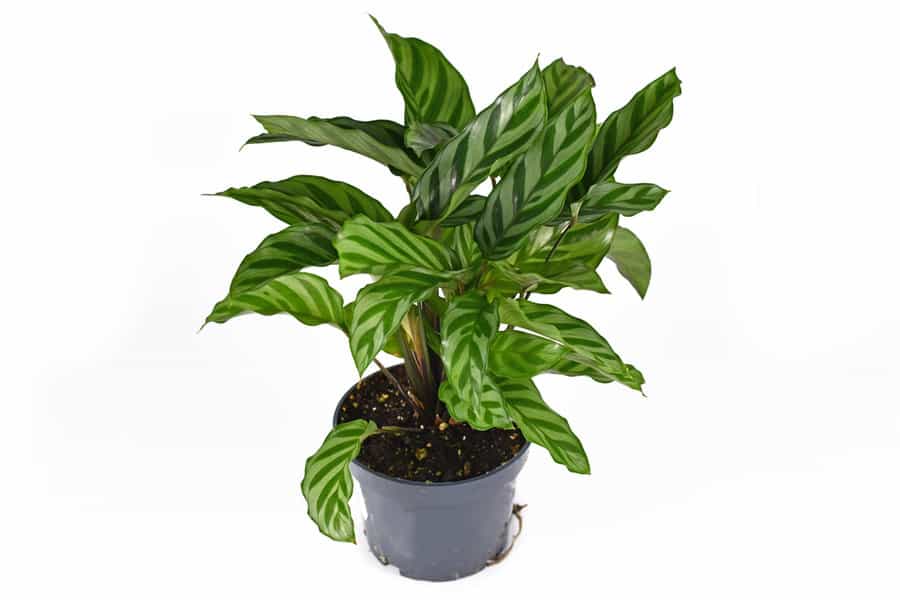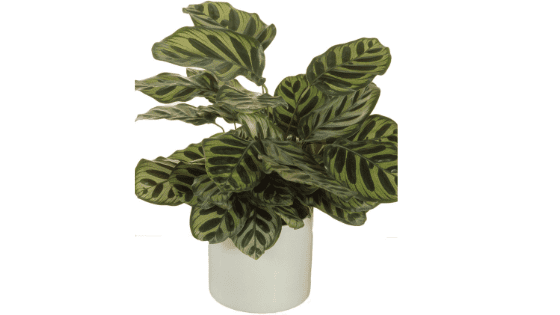The Calathea Freddie plant isn’t for the occasional gardener. It requires plenty of attention and love, but it can grow into a beautiful and unique plant with proper care. Its bright and bold foliage brings a unique look to any home or garden.
Table of Contents
Calathea Freddie Overview
The Calathea Freddie plant is a part of the Prayer Plant Calatheas. They received this name because the plant is open during the day to absorb the sun’s rays, but then at night, the leaves withdraw to replenish themselves, much like humans do when they sleep.
The Freddie Calathea is called ‘Zebra plant’ because of its striped leaves. The plant is also a perennial. It comes from the tropical lands of South America, mainly Brazil.
The South American native flowering plants are in the Marantaceae family and the Calathea genus.
| Botanical Name | Calathea Leopardina |
| Family | Marantaceae |
| Genus | Calathea |
| Origin | Brazil |
| Sunlight | Bright indirect light |
| Watering | Consistent watering in warmer months |
| Soil | Moist soil in a well-draining pot |
| Temperature | 65 – 75 degrees |
| Propagation | 3 shots for each plant |
| Re-Potting | Every spring as needed |
| Pests and Diseases | Yellow or curling leaves |
| Toxicity | Nontoxic |

Calathea Freddie Features
Calathea Freddies are great indoor or outdoor plants that grow to two to three feet tall in the right conditions. It has long pointed leaves with alternating dark and light green stripes that extend to four to seven inches long.
The plant blooms white flowers that bloom on a long stalk-like inflorescence from the middle of the plant.
The Calathea Freddie plant is nontoxic for animals or humans, so it’s safe to have around your pets and kids. However, it’s best to prevent animals or children from playing with or ingesting the leaves.
Calathea Freddie Care Guide
Caring for Calathea Freddie plants is a bit tricky. It’s not for the occasional or forgetful gardener. However, this Brazilian native tropical plant loves attention and will reward you for proper care.
Ideal Growing Place
The Calathea Freddie grows well indoors and outdoors in the right conditions. It grows best in USDA Harding zones 10 – 11, and outdoors is an excellent ground cover. Outdoors it does well in the spring and summer, but it should come indoors when the weather cools in the late fall and winter.
Water
The Calathea Concinna Freddie doesn’t tolerate dry soil but doesn’t tolerate over-watering either. It likes its soil moist, and the best practice is to water when it is 70% dry. When you water the Freddie plant, let the water drain from the drainage holes entirely before placing the pot back in its place if it’s an indoor plant.
Before watering the Freddie plant, stick your finger in the soil. If the top two inches feel dry, it’s time to water. If you water too much, you could cause root rot and fungus issues. In the warmer months, you’ll water one to three times a week, and in the colder months, just once a week.
Sunlight
The Freddie plant likes bright indirect light. At a minimum, the plant should have six hours of indirect light. If you have indoor plants, keep the Calathea Concinna near north, east, or west-facing windows for indirect light.
Give the plant as much morning sunlight as possible while avoiding more intense afternoon sunlight. Direct sunlight will burn the leaves and could harm your plant’s health.
Temperature
Ideally, the Calathea Concinna Freddie plant likes temperatures between 65 and 75 degrees Fahrenheit. Unfortunately, this plant does not tolerate cold temperatures because of its tropical history. If it’s exposed to temperatures below 59 degrees, it might not survive.
If you have the plant outdoors, bring it indoors when the weather drops to protect it.
Soil
The soil requirements for the Freddie plant are pretty specific. It needs well-draining soil but moist soil too. They do well with a peat-based mixture. If you’re mixing soil yourself, use two parts peat and one part perlite.
If you use pebbles, place them in the soil, not at the top. If you place pebbles at the top, it could suffocate the plant.
Humidity
Because the Freddie Calathea is a tropical plant, it loves high humidity. Therefore, the moisture level should be around 70 percent. You can achieve this by grouping plants together, using a humidifier, or putting a pebble water tray under the plant.
Fertilizer
Calathea Concinna care includes fertilizing the plant, but not year-round. Instead, fertilize it once a month in the spring and summer, not during the cold weather, starting in late fall and winter.
Pinching/Pruning
Pruning the Freddie plant is essential to having a healthy plant. Trim dead leaves from the bottom first. This will enhance the plant’s health and make it look better too. To clean the plant, wipe the leaves with a mildly damp cloth. This stops the leaves from collecting dust particles which can harm the plant’s health.
Potting and Re-potting
If you pot your Freddie Calathea, place it in a medium-sized pot with adequate drainage holes. You won’t have to repot it for at least two years. Then, if the soil looks old, or you want to give your Freddie plant fresh soil, it won’t argue. Do this once a year at most, though. It’s best to do the repotting process in early spring for the best results.
Growth Zone
The ideal USDA growth zones are zones 10 and 11. You can confidently grow these plants outdoors if you live in these zones. Otherwise, they make great house plants in other zones; just make sure to water the soil regularly and give it low indirect light.
Common Pests, Toxins, Diseases & Other Problems
The most common problems with the Calathea Concinna Freddie plant are the leaves.
If your plant’s leaves turn yellow, it could be due to poor water quality. Therefore, it’s best to avoid tap water when watering your plant. If you must use tap water, boil it and let it cool before watering your plant.
Lack of humidity and dry soil can also cause yellow leaves. However, if you keep the soil moist and the humidity levels adequate, you shouldn’t face these problems.
If your plant’s leaves curl, it could be due to where you have it sitting. Cold or dry air cause the leaves to curl. Keep it away from drafts or any direct air source. Tap water can also cause the leaves to curl, so use deionized water to maintain your plant’s health.
Related Article: 10 Best Plants Which Are Great For Your Garden
Propagation
To propagate your Freddie plant, use the plant division method. It’s best to do this in early spring when you repot the plant. To divide the plant:
- Choose a healthy plant that has a decent size.
- Gently shake the plant to remove excess soil and carefully separate the roots.
- Have at least three shots in each for the best chance at a healthy plant.
Report the parent plant into fresh soil and the divided roots into another pot of healthy soil. Give the plant low indirect sunlight and moist soil. You can either keep watering the soil to keep it most or cover the pot with plastic wrap to avoid moisture loss. The plant will settle and begin growing in about three to four weeks.
Calathea Freddie Mature Timeline
Here’s a quick look at the Freddie plant’s timeline.
Day 1 to 30: The plant should lay low in a warm spot with plenty of moisture.
Day 30 to 60: Remove the plastic cover and watch the plant grow at about the fifth or sixth week.
Day 60 and on: Move the plant to medium light, but make sure it’s indirect light. Don’t do this all at once, though. Instead, gradually introduce it to brighter light so it can adapt.

Calathea Freddie FAQ
What Are the Calathea Freddie Benefits?
The Calathea Freddie plant is a beautiful plant that adds to your home decor. Its unique appearance is a conversation starter and adds color to your home. The plant also produces oxygen and kills harmful pollutants in the house.
What’s the Difference Between Calathea Freddie vs Bella?
The Calathea Freddie plant has a zebra-like appearance, and the Bella plant has a more mosaic pattern and isn’t as vivid green.
How Old Does Calathea Freddie Have to Be Before They Bloom?
The Calathea Freddie blooms flowers every spring or summer in the right conditions. This means moist soil and proper humidity levels.
Is Calathea Concinna a Fast Grower?
The Calathea Concinna plant is labeled as a moderate grower. It takes about 2 feet (its highest height) in about one year.
How Big Does a Calathea Freddie Get?
The plant reaches about two to three feet at maturity.
Why Are the Leaves on My Calathea Freddie Curling?
Curling leaves are usually a sign that the plant is too close to airflow or that the water has toxins. If you’re using tap water, let it sit out for a few days or boil it before use. You can also use deionized water to water your plant.
Why Do Calathea Leaves Stand at Night?
The standing leaves at night are a sign of a healthy plant. It’s their way of reaching for a light source that isn’t as readily available as it is during the day.
What Does Calathea Freddie Smell Like?
The Calathea Freddie flowers have a lovely scent when they bloom.
Is Calathea Freddie a Prayer Plant?
Yes, the Calathea Freddie is a part of the prayer plant family.
Is the Freddie Calathea Easy to Care For?
The Freddie plant is temperamental. If you’re looking for an easy-to-care-for plant, this isn’t it. The Freddie plant requires plenty of watering and observation to ensure it has the proper humidity levels.
Is Calathea Freddie a Succulent?
The Calathea Freddie plant isn’t a succulent.
How Long Do Calathea Freddie Plants Live?
With proper care, the Calathea plant can live for decades. However, it might only last a few months if you don’t provide the appropriate water and humidity levels.
What Kind of Pot Is Suitable for a Calathea Freddie?
Use a medium-sized pot when potting your Freddie plant. If it outgrows its pot, repot it in the spring months.
Is Calathea Freddie Rare?
The beautiful Calathia Freddie plant is relatively easy to find to add to your indoor and outdoor plantations.
Is Calathea Freddie Toxic to Pets and Humans?
The Calathea Freddie plant is nontoxic. However, it’s best to keep all plants away from children and pets.
The Bottom Line
The Calathea Freddie plant is an excellent option if you want a unique plant with beautiful stripes and an ever-changing mood. Just make sure you’re capable of providing ongoing care as it’s a needy plant with many requirements.
Last Updated on September 3, 2022 by Gustaf Johansson




